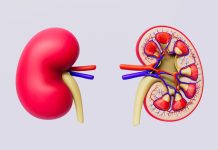
In a study from Maastricht University, scientists found that shivering during repeated exposure to cold improves glucose tolerance, decreases fasting blood sugar and blood fat levels, and markedly reduces blood pressure in overweight and obese people
The finding highlights the potential for repeated cold exposure that activates shivering as an alternative strategy to treat and prevent type 2 diabetes (T2D).
Previous research has shown that when humans are cold, blood sugar is cleared from the blood faster.
Brown fat was thought to play a major role in lowering blood sugar and improving insulin sensitivity in humans, thereby helping to reduce insulin resistance and the risk of diseases, including diabetes.
A previous study found that 10 days of mild cold acclimation (14 to 15°C, 6 hours per day) strongly improved insulin sensitivity in patients with type 2 diabetes.
In the study, the team found that some level of (mild) muscle activity/shivering may be crucial in activating the beneficial metabolic effects of cold.
They exposed volunteers—11 men and 4 women with overweight or obese- to 10 consecutive days of cold to activate shivering, using a water-perfused suit to control and lower body temperature.
Participants were exposed to cold, from 32°C to 10°C, until they shivered for one hour per day.
The team showed that repeated cold-induced shivering strongly reduced blood sugar levels from 5.84 to 5.67 mmol/L, and improved glucose tolerance by 6%.
They also found the improved fasting glucose and glucose tolerance after repeated shivering was not because of increased insulin in the blood.
Interestingly, triglyceride and free fatty acid levels were markedly reduced by 32% and 11%, respectively.
These are the major fat fuels in the body and are thought to raise the risk of heart disease and contribute to insulin resistance.
In addition, repeated cold exposure also markedly reduced systolic and diastolic blood pressure by around 10 mmHg and 7 mmHg, respectively, and tended to reduce resting heart rate when measured under thermoneutral conditions.
They also found that other changes occurred in skeletal muscle, and/or potentially, other organs that explain the improved glucose tolerance.
These findings are promising and may have important health implications, given that shivering improved many cardiometabolic health outcomes which are associated with diseases like type 2 diabetes.
If you care about diabetes, please read studies about berries that can help prevent diabetes, obesity, and cancer, and new drugs to treat diabetes and metabolic syndrome.
For more information about diabetes, please see recent studies about the normal blood sugar for people with diabetes, results showing that Zinc may be key to better diabetes treatments.
The study was conducted by Adam Sellers et al and presented at this year’s European Association for the Study of Diabetes (EASD) Annual Meeting
Copyright © 2022 Knowridge Science Report. All rights reserved.



